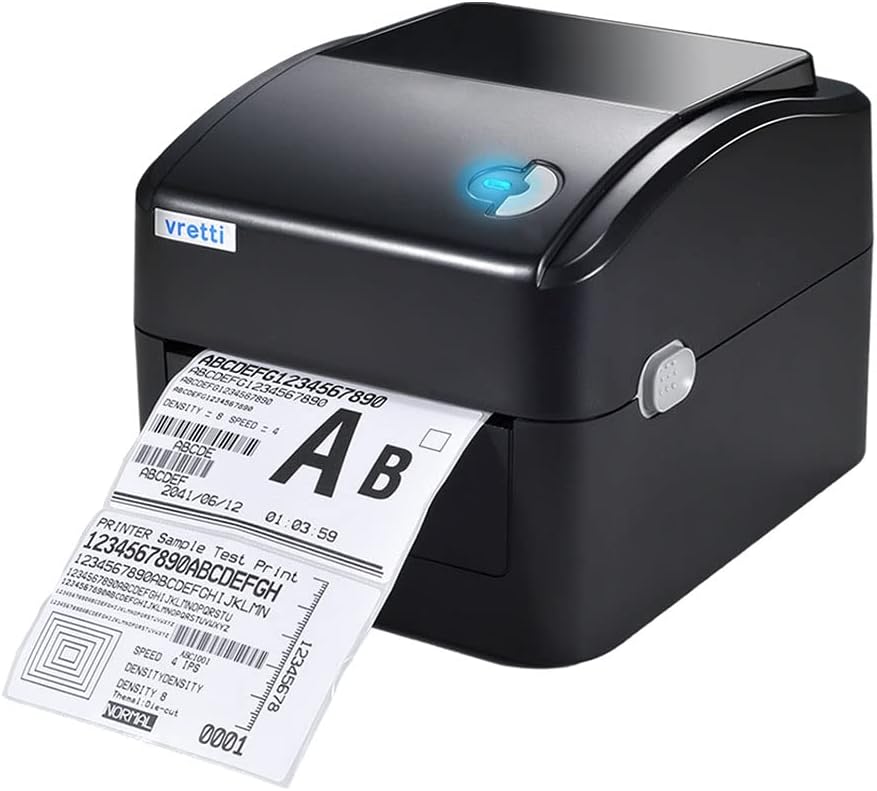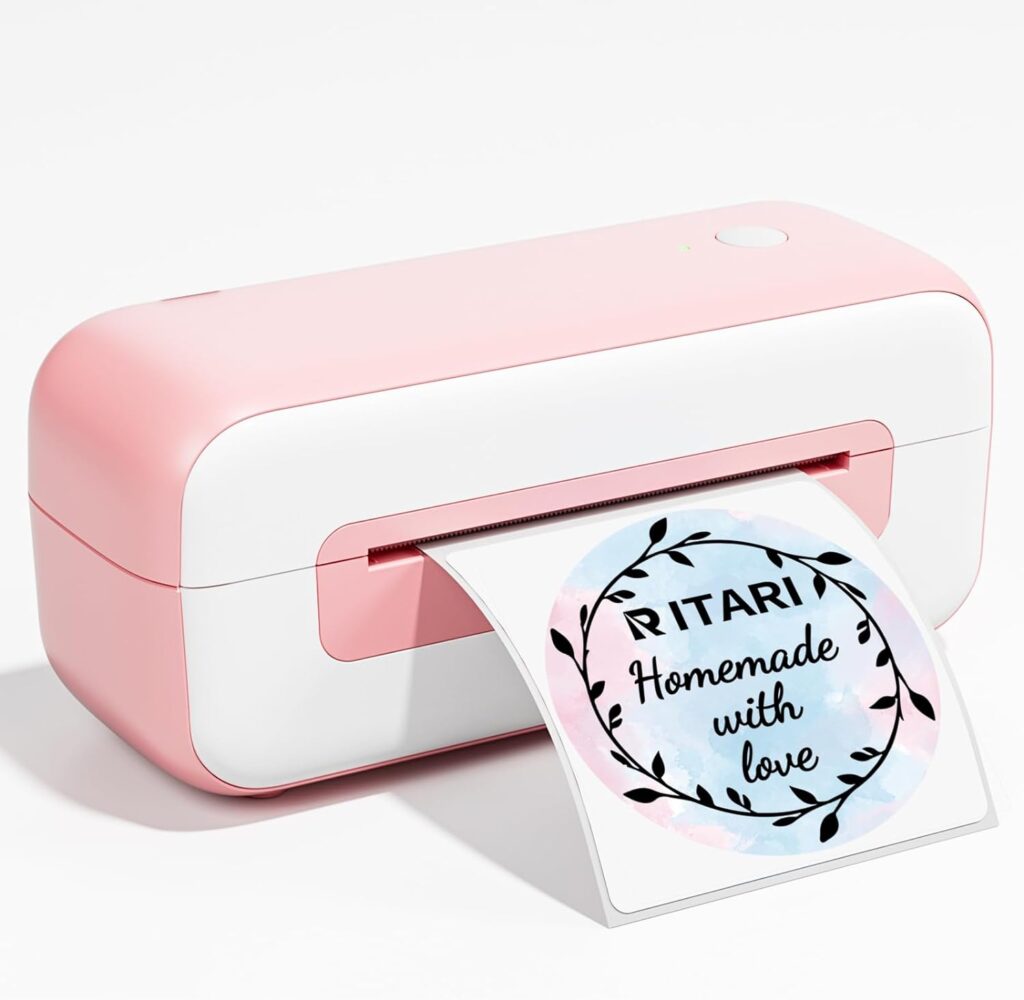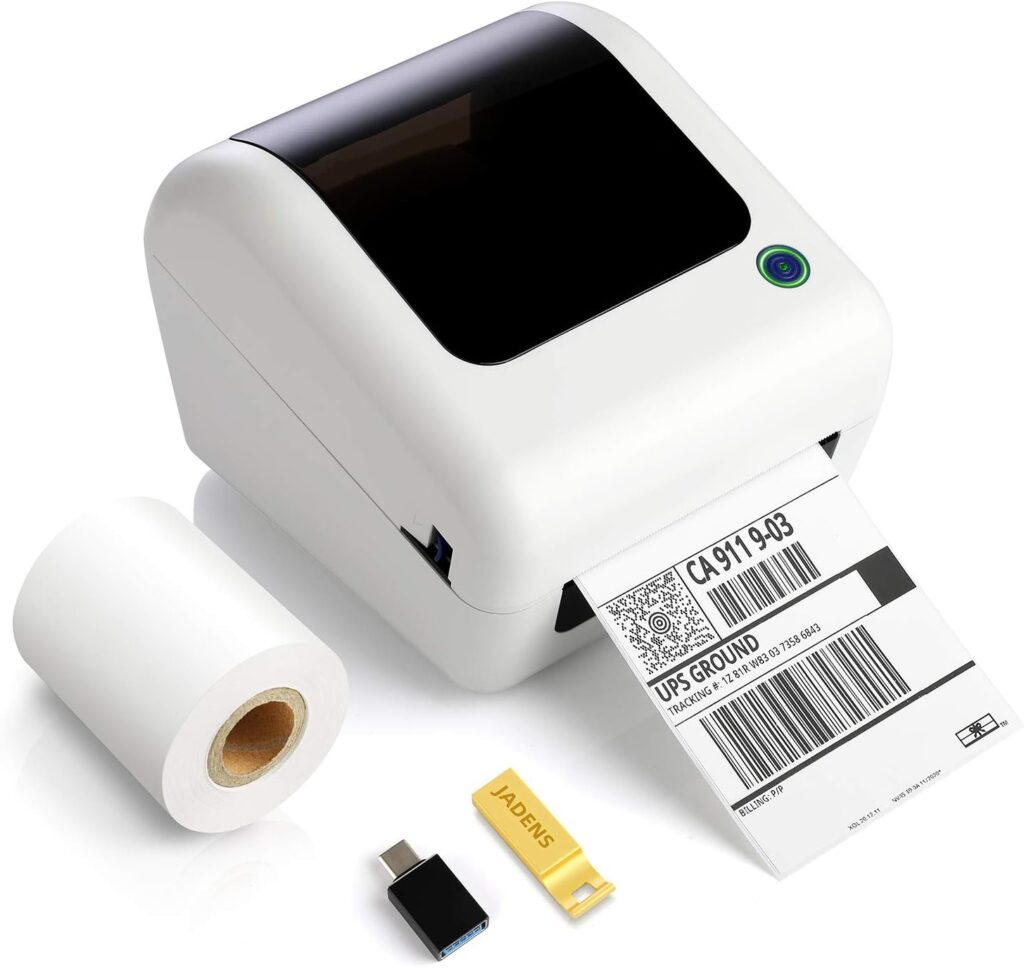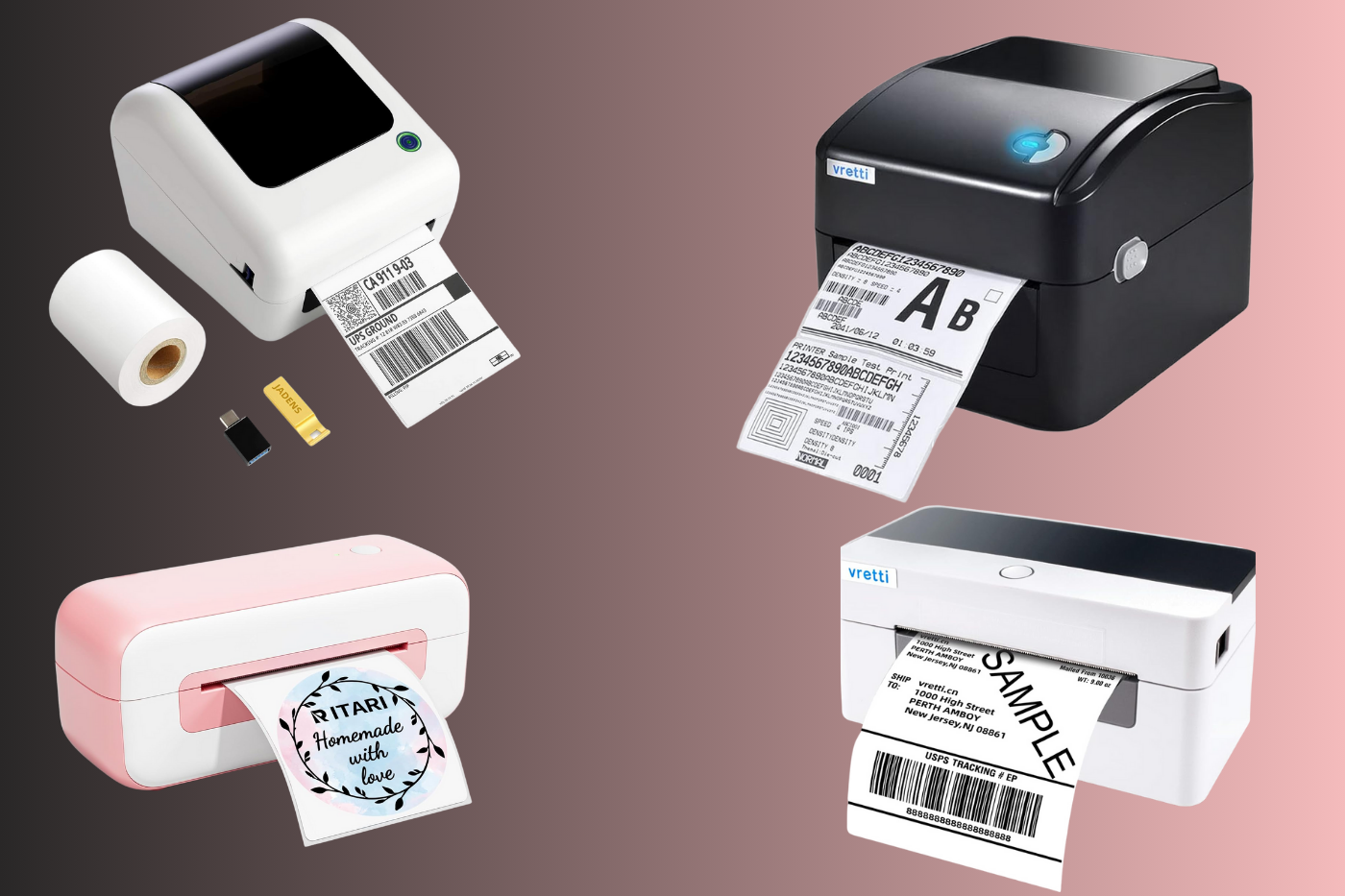A thermal label printer is a device that uses heat to print images and text. It uses special thermal technology, which means it heats special thermal paper or ribbon to produce printed material. This type of printer is known for its accuracy and efficiency, making it ideal for a variety of labeling tasks.
Table of Contents
Common Use
Thermal label printers are incredibly versatile and are commonly used for:
Labels: Create labels for products, shipping, and inventory management.
Receipts: Printing sales receipts in a retail environment.
Barcodes: Generating barcodes for tracking and identification.
Shipping Labels: Creating shipping labels for packages.
These printers are designed to handle high-volume printing needs with speed and accuracy.
Importance in different industries
Thermal label printers play an important role in a number of industries due to their reliability and cost-effectiveness:
Retail: They streamline the process of labeling products, printing price tags, and generating customer receipts.
Logistics and Shipping: They are essential for printing shipping labels and barcodes, which are essential for tracking and managing shipments.
Manufacturing: Used to label products, components, and parts, ensuring accurate tracking and quality control.
Healthcare: They are used to print patient wristbands, prescription labels, and other important identification labels.
These printers are favored across industries because they reduce the need for ink or toner, reduce operational costs, and provide high-quality, durable prints that are essential for a variety of applications.
Types of Thermal Label Printers

Direct thermal printers
Direct thermal printers work by applying heat directly to specially coated thermal paper. This heat causes the paper to change color and produce the desired image or text. Here are the main features:
No ink or ribbon required: Direct thermal printers require no ink, toner, or ribbon, making them cost-effective and easy to maintain.
Best for short-term use: Prints from direct thermal printers can fade over time and are sensitive to heat and light, making them suitable for short-term applications such as shipping labels, receipts and temporary tags.
Low maintenance: With fewer components, such as ribbons to replace, direct thermal printers have low maintenance requirements.
Thermal transfer printers
Thermal transfer printers use a different method involving a ribbon that holds ink. When heat is applied, the ink transfers from the ribbon to the label material. Key features include:
Durable Prints: Thermal transfer prints are more resistant to environmental factors such as heat, light and chemicals, making them ideal for long-term use.
Versatile printing: These printers can print on a variety of materials, including paper, polyester, and polypropylene, which is beneficial for making labels that need to withstand harsh conditions.
More maintenance: Thermal transfer printers require periodic ribbon replacement and potentially more maintenance than direct thermal printers.
Comparison of direct thermal and thermal transfer printers
Cost: Direct thermal printers are generally less expensive initially and have lower costs because they do not require a ribbon. Thermal transfer printers can have high initial and ongoing costs due to the use of ribbons.
Durability: Prints from thermal transfer printers are more durable and suitable for long-term applications, while direct thermal prints are best for short-term needs.
Application: Choose direct thermal for short-term labeling, such as shipping labels and receipts. Choose thermal transfer when you need durable, long-lasting labels for industrial, outdoor, or archival use.
Understanding the differences between these two types of thermal label printers helps select the right printer based on specific labeling needs and intended application environment.
Key Components of Thermal Label Printers
Thermal label printers consist of several essential components that work together to produce high-quality prints. Understanding these components helps in troubleshooting and maintaining the printer.

Print head
Function: The printhead is the main component that generates heat to create the image or text on the label.
Operation: In direct thermal printers, the print head heats the thermal paper directly. In thermal transfer printers, heat the ribbon, transferring the ink to the label material.
Maintenance: Regular cleaning is essential to prevent residue build-up and ensure clear, consistent printing.
Platen
Function: The platen is a rubber roller that feeds paper or label material through the printer.
Operation: It works in conjunction with the print head, pressing the paper or ribbon against the heated print head to create the print.
Maintenance: Keep the plate clean and free of debris to ensure smooth operation and avoid print quality problems.
Sensors
Function: Sensors detect the presence and position of labels, gaps, or marks on media.
Types: Common types include gap sensors (detecting gaps between labels) and mark sensors (detecting black marks on the back of the media).
Role: They ensure accurate printing by accurately aligning the printhead with the label material, preventing misprints and material wastage.
Ribbon (for thermal transfer printers)
Function: The ribbon contains the ink used in thermal transfer printing.
Operation: The print head heats the ribbon, transferring the ink to the label material.
Types: Ribbons come in a variety of materials, such as wax, resin, or wax-resin mix, each suited to different applications and durability requirements.
Maintenance: Replace ribbons regularly and ensure they are compatible with the printer and label material for best print quality.
Summary of component interactions
The print head and platen: work together to apply the image to the label. The printhead generates heat, and the platen ensures constant pressure and movement of the label material.
Sensors and Printhead Alignment: Sensors guide the printhead to ensure labels are printed accurately and consistently.
Ribbon and Printhead: In thermal transfer printers, the ribbon and printhead assist in transferring ink to the label, producing durable and long-lasting prints.
Understanding these key components and their functions helps maintain the printer, troubleshoot problems, and ensure high-quality print outputs. Regular maintenance, such as cleaning the printhead and platen and proper handling of the ribbon and sensor, are critical to the printer’s optimal performance.
Advantages of Thermal Label Printers
Thermal label printers offer several key advantages that make them the preferred choice for various labelling needs across industries.

Cost efficiency
Lower operating costs: Thermal printers eliminate the need for ink, toner, or cartridges, reducing ongoing costs associated with printing.
Consumables savings: Direct thermal printers require only thermal paper, while thermal transfer printers use ribbons that are cost-effective and long-lasting.
Minimal maintenance: With fewer moving parts and an inkless system, these printers require less frequent maintenance, further reducing costs.
Speed and Reliability
Fast printing speed: Thermal printers can produce labels quickly, making them ideal for high-volume environments such as retail, logistics, and manufacturing.
High throughput: They can handle continuous printing without interruption, which is essential for businesses that rely on efficient label production.
Consistent performance: Thermal printers are designed to deliver consistent print quality over long periods of time, ensuring reliable operation even during heavy use.
Quality and Durability
Fast and clean prints: Thermal printing technology produces accurate, high-resolution images and text, making labels easy to read and scan.
Durable outputs: Thermal transfer prints are particularly durable and resistant to fading, smudges, and environmental factors such as heat and chemicals. This makes them suitable for labels that need to last for long periods of time or withstand harsh conditions.
Material Versatility: Thermal transfer printers can print on a wide range of materials, including synthetic labels, which are ideal for outdoor or industrial use.
Environmental benefits
Less waste: The lack of ink cartridges or toner reduces waste, and consumables (such as ribbons) often have a longer life.
Energy efficiency: Thermal printers typically use less electricity than other types of printers, which contributes to lower energy consumption and operational costs.
Choosing the Right Thermal Label Printer
Choosing the right thermal label printer for your needs involves considering several factors to ensure it meets your specific needs. Here are the main considerations:
Consider printing requirements
Printing Volume: Estimate how many labels you need to print daily or monthly. High-volume environments may require a more robust printer capable of handling large print jobs without frequent maintenance.
Label size and type: Determine the size and type of label you need. Some printers are designed for small, precise labels, while others can handle larger formats.
Assess sustainability requirements
Short-term vs. long-term labeling: Direct thermal printers are best suited for short-term labeling needs, such as shipping labels or receipts that don’t need to last long. Thermal transfer printers are ideal for long-term labeling that requires durability and resistance to environmental factors.
Environmental Conditions: Consider the conditions to which the label will be exposed. If labels need to withstand harsh environments, such as extreme temperatures, humidity, or chemicals, thermal transfer printing with durable materials is essential.
Assess connectivity options
USB: Most thermal label printers come with USB connectivity, suitable for direct connection to a computer or other device.
Ethernet: For networked environments, Ethernet connectivity allows multiple users to access the printer over a network.
Wireless capabilities: Wi-Fi-enabled printers offer the flexibility of wireless printing, which is convenient in dynamic and mobile work environments.
Bluetooth: Bluetooth connectivity is useful for printing from mobile devices and tablets.
Budget Considerations
Initial Cost vs. Long-Term Savings: While direct thermal printers may have lower initial costs, thermal transfer printers can offer long-term savings due to their durability and lower maintenance requirements.
Consumables: Consider the cost and availability of consumables such as thermal paper and ribbon. Make sure the printer you choose has a compatible and affordable supply.
Maintenance and Care of Thermal Label Printers
Proper care and maintenance is essential to ensure longevity and optimal performance of thermal label printers. Here are key ways to keep your printer in top condition:
Regular cleaning
Printhead: Clean the printhead regularly using a special cleaning pen or broom to remove dirt, debris, and residue build-up. This ensures clear and consistent printing.
Platen: Keep the platen clean and free of dust and debris. Use a soft cloth dampened with water or alcohol to clean the platinum surface.
Interior and Exterior: Periodically clean the interior and exterior of the printer to remove dust and debris that can affect performance and appearance.
Adequate storage
Thermal Paper: Store thermal paper in a cool, dry place away from direct sunlight and heat sources to prevent discoloration and degradation.
Ribbon: If using a thermal transfer printer, store ribbons in their original packaging in a clean, dry environment to maintain ink quality and prevent drying.
Preventive maintenance
Scheduled maintenance: Implement a regular maintenance schedule to inspect and clean printer components, ensuring smooth operation and preventing potential problems.
Replace Consumables: Replace thermal paper rolls and ribbon as needed to avoid downtime and maintain print quality.
Check for wear and tear: Regularly inspect printer components for signs of wear and tear, such as frayed cables or damaged rollers, and replace them promptly to prevent further damage.
Solving common problems
Paper jams: Clear paper jams immediately by following the printer’s manual instructions. Carefully remove any jammed paper to avoid damaging the printer.
Print quality problems: Resolve problems such as faint prints, streaks, or spots by cleaning the print head, adjusting print settings, or replacing consumables if necessary.
Connectivity issues: Troubleshoot connectivity issues by checking cables, connections and settings. Make sure the printer drivers are up to date.
Professional Maintenance
Manufacturer Support: Contact the manufacturer or an authorized service provider for professional maintenance and repair if needed. Follow their recommendations for servicing intervals and procedures.
Training: Provide training to staff members responsible for printer maintenance to ensure proper handling and maintenance of equipment
Conclusion
In conclusion, thermal label printers are indispensable tools for businesses in various industries due to their efficiency, reliability and versatility. Utilizing thermal printing technology, these printers offer several advantages, including cost-effectiveness, fast printing speed, and high-quality output. Whether used in retail, logistics, healthcare, or manufacturing, thermal label printers streamline the labeling process, improve accuracy, and increase productivity.
Choosing the right thermal label printer involves considering factors such as printing needs, durability requirements, connectivity options, and budget considerations. Proper care and maintenance is crucial to ensure optimal printer performance and longevity. With regular cleaning, preventative maintenance, and prompt troubleshooting, businesses can maximize the lifespan and performance of their thermal label printers.
As experts in the field, we recommend investing in high-quality thermal label printers tailored to your specific needs and implementing a proactive maintenance routine to keep them running smoothly. With the right printer and maintenance practices in place, businesses can optimize their labeling processes, improve operational efficiency, and effectively achieve their business goals.


1 thought on “What is Thermal label printer?”